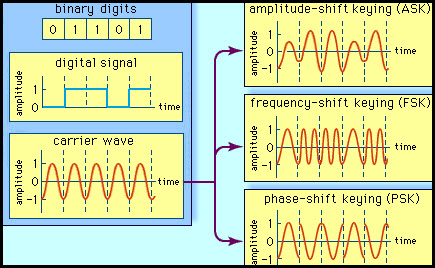MODULATION IN TELECOMMUNICATION
Modulation:-
In several telecommunications systems, it's necessary to represent associate degree information-bearing signal with a wave shape which will pass accurately through a transmission medium. This assignment of an acceptable wave shape is accomplished by modulation, that is that the method by that some characteristic of a radio wave is varied in accordance with associate degree info signal, or modulating wave. The modulated signal is then transmitted over a channel, when that the first information-bearing signal is recovered through a method of reception. Modulation is applied to info signals for variety of reasons, a number of that ar printed below. Many transmission channels Ar characterized by restricted pass bands—that is, they'll pass solely sure ranges of frequencies while not seriously attenuating them (reducing their amplitude). Modulation strategies should thus be applied to the data signals so as to “frequency translate” the signals into the vary of frequencies that ar permissible by the channel.samples of channels that exhibit pass band characteristics embrace alternating-current-coupled concentrical cables, that pass signals solely within the vary of sixty kilocycle to many hundred Mc, and fibre-optic cables, that pass lightweight signals solely at intervals a given wavelength vary while not vital attenuation.
modulation-techniques-in-communication-system
In these instances frequency translation is employed to “fit” the data signal to the communications channel. In several instances a communications channel is shared by multiple users. so as to stop mutual interference, every user’s info signal is modulated onto associate degree allotted carrier of a selected frequency. once the frequency assignment and ensuant combining is completed at a central purpose, the ensuing combination may be a frequency-division multiplexed signal, as is mentioned in Multiplexing. often there's no central combining purpose, and also the communications channel itself acts as a distributed mix. associate degree example of the latter scenario is that the broadcast radio bands (from 540 kilocycle to 600 megahertz), which enable concurrent transmission of multiple AM radio, FM radio, and tv signals while not mutual interference as long as every signal is allotted to a distinct band. Even once the communications channel will support transmission mechanism of the information-bearing signal, there ar usually sensible reasons why this can be undesirable. an easy example is that the transmission of a three-kilohertz (i.e., voiceband) signal via radio emission.In free house the wavelength of a three-kilohertz signal is a hundred kilometers (60 miles). Since a good radio aerial is often as giant as the wavelength of the signal, a three-kilohertz radio emission would possibly need associate degree antenna up to fifty kilometers long. during this case translation of the voice frequency to the next frequency would permit the employment of a far smaller antenna. Analog modulation As is noted in analog-to-digital conversion, voice signals, still as audio and video signals, ar inherently analog in kind. In latest systems these signals ar digitized before transmission, however in some systems the analog signals ar still transmitted directly while not changing them to digital kind.
There ar 2 unremarkably used strategies of modulating analog signals. One technique, known as AM, varies the amplitude of a fixed-frequency radio wave in proportion to the data signal. the opposite technique, known as modulation, varies the frequency of a fixed-amplitude radio wave in proportion to the data signal. Digital modulation In order to transmit laptop knowledge and different digitized info over a communications channel, associate degree analog radio wave are often modulated to replicate the binary nature of the digital baseband signal. The parameters of the carrier which will be changed ar the amplitude, the frequency, and also the part.

Comments
Post a Comment